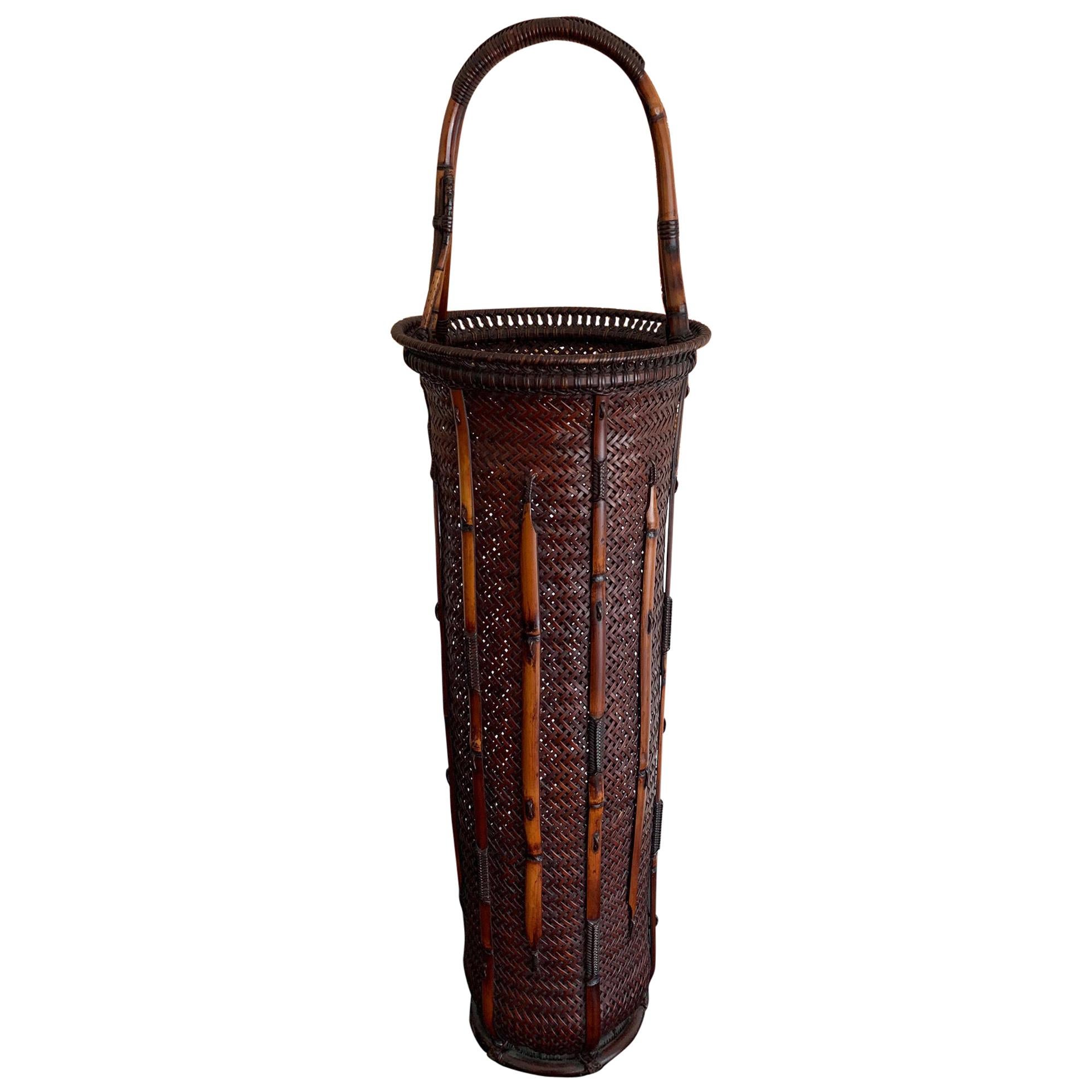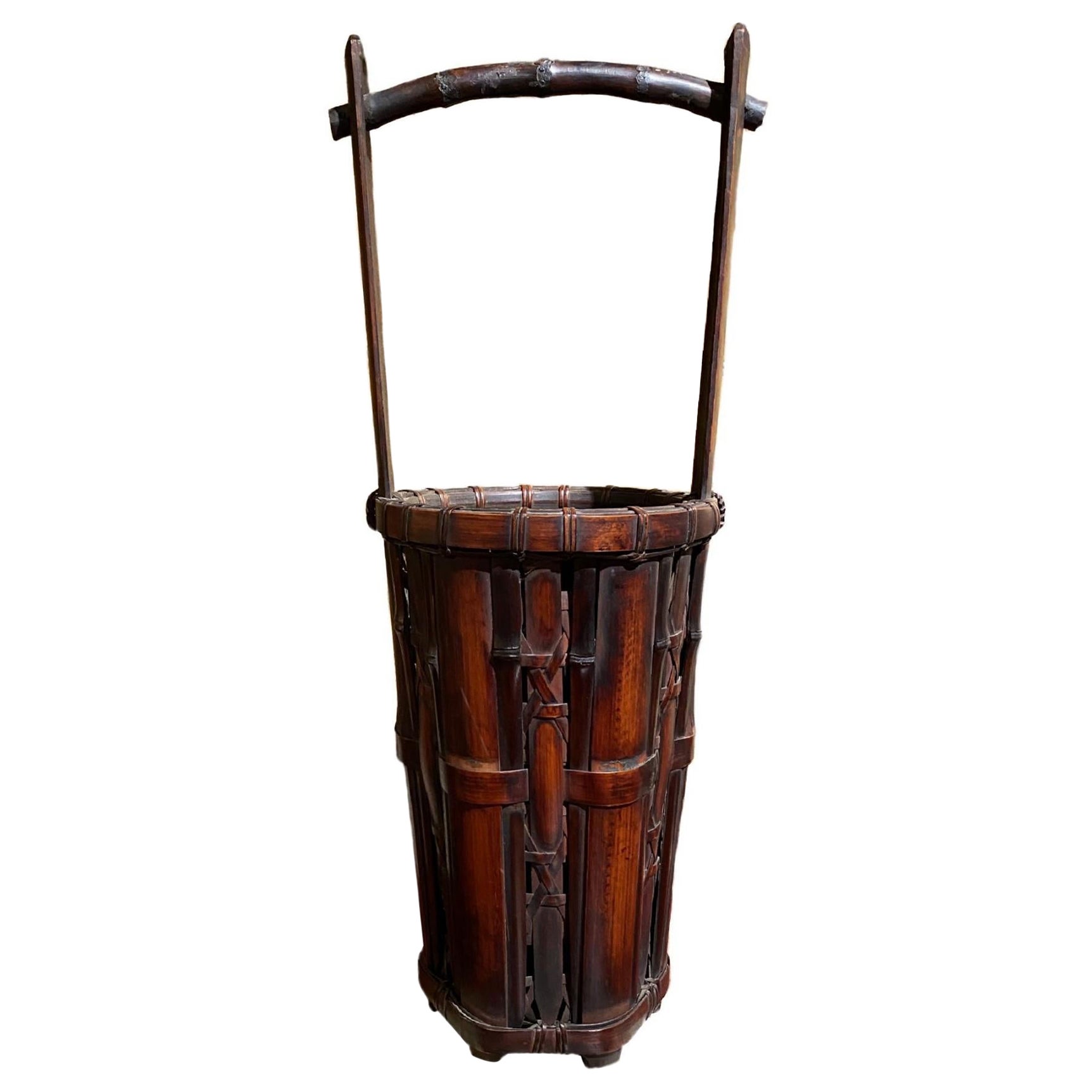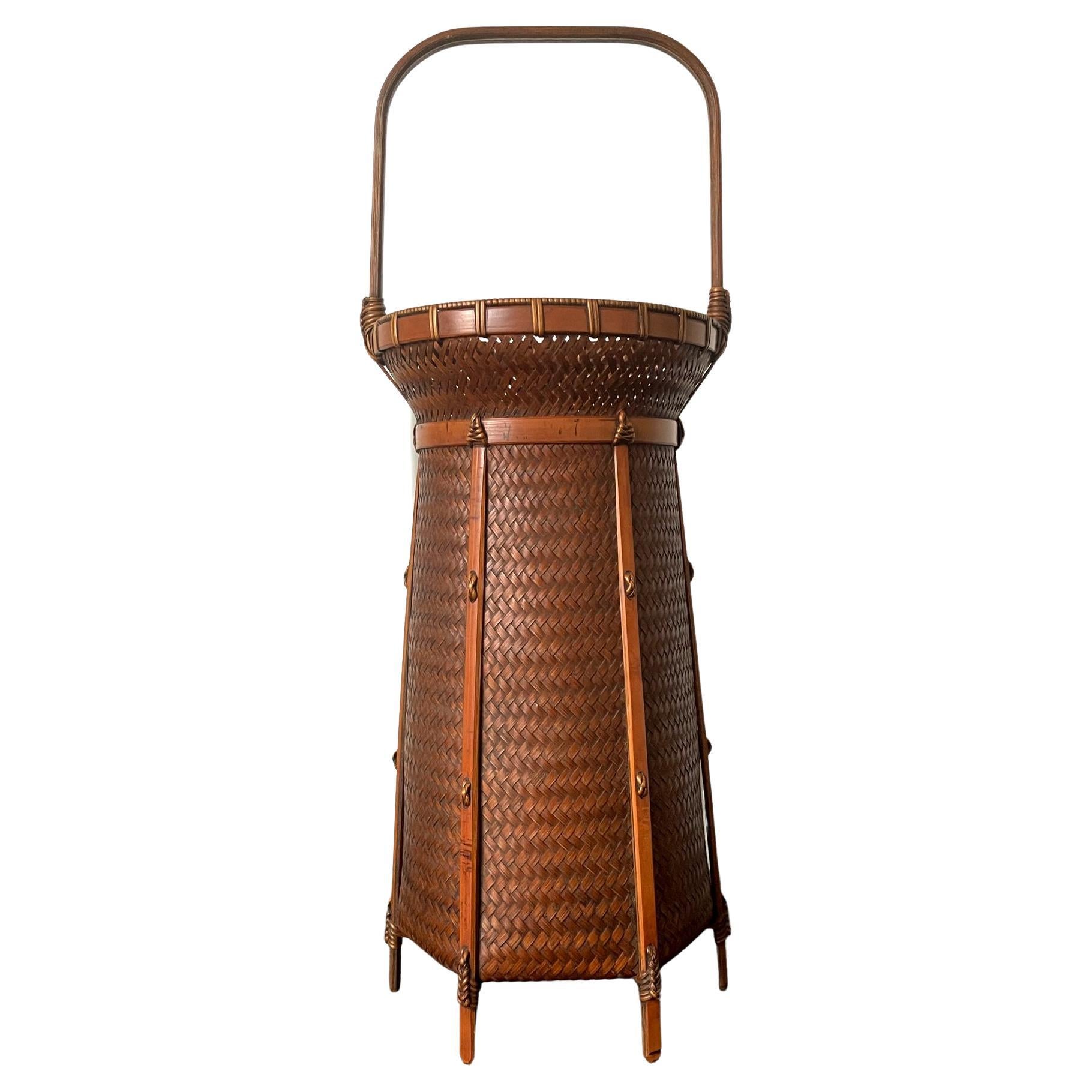Items Similar to Japanese Woven Bamboo Brazier by Maeda Chikubosai I
Want more images or videos?
Request additional images or videos from the seller
1 of 13
Japanese Woven Bamboo Brazier by Maeda Chikubosai I
About the Item
An important piece of bamboo basketry art by Maeda Chikubosai I (1872-1950), circa 1920s-1930s. The body of the bamboo brazier was made with smoked bamboo (susudake) and rattan and with a built-in copper liner brazier. Mat plaiting, diagonal plaiting and twining were used to construct the robust body while hexagonal plaiting was used for the base. It is signed on the base Chikubosai Kore o tsukuru (Chikubosai made this). The copper brazier has clear patina of being used for fire. The piece is however incredibly preserved in fine condition.
A pair of nearly identical braziers are illustrated in the book "Baskets Master Pieces of Japanese Bamboo Art 1850-2015 page 392, illustration 163 (as shown).
Chikubosai I was from the Kansai Region and active in Sakai, Osaka prefecture. He was instructed by Wada Waichisai I, (1851-1901).
- Creator:Maeda Chikubosai (Artist)
- Dimensions:Height: 10 in (25.4 cm)Diameter: 13.5 in (34.29 cm)
- Style:Japonisme (Of the Period)
- Materials and Techniques:
- Place of Origin:
- Period:
- Date of Manufacture:1920s-1930s
- Condition:Wear consistent with age and use. Copper liner with use wear as shown, bamboo surface shows a wonderful smoked patina.
- Seller Location:Atlanta, GA
- Reference Number:1stDibs: LU945019304082
About the Seller
5.0
Platinum Seller
These expertly vetted sellers are 1stDibs' most experienced sellers and are rated highest by our customers.
Established in 2006
1stDibs seller since 2010
477 sales on 1stDibs
Typical response time: <1 hour
- ShippingRetrieving quote...Ships From: Atlanta, GA
- Return PolicyA return for this item may be initiated within 2 days of delivery.
More From This SellerView All
- Large Japanese Woven Bamboo Morikago Basket by Maeda Chikubosai IBy Maeda ChikubosaiLocated in Atlanta, GAA large and impressive Japanese basket in the form of a morikago by Maeda Chikubosai I (1872-1950) circa first half of the 20th century. Chikubosai I was from the Kansai Region and active in Sakai, Osaka prefecture. He was instructed by Wada Waichisai I, (1851-1901). Morikago is a shallow open basket with handle. It was traditionally used to display fruits, sometimes flowers, during Sencha tea ceremony. In contrast to Chanoyu, Sencha ceremony uses loose green tea leaves instead of tea powder. The placement of loose fruits in the basket meant that the pattern of the bottom, which is often elaborate, was meant to be visible. This morikago was beautifully constructed with bent bamboo frame and twill plaits for the body. The bottom of the basket features a double diamond pattern achieved with a variation of plover plait. The bifurcated handles was bundle-plated with a rather free spirit approach. They show a poetic suggestion of movement, as if the bamboos were still swaying in the wind. The basket has a copper insert that fits perfectly and it is quite possibly the original. The basket is signed on the base "Chikubosai". The style of the signature shows that it was made by Maeda Chikubosai I. For another Morikago basket by Maeda Chikubosai I, see page 79 of "Masters of Bamboo" by Rinne. For the study of the signature of Chikubosai I "Baskets Master Pieces of Japanese Bamboo Art...Category
Early 20th Century Japanese Japonisme Decorative Baskets
MaterialsCopper
- Large Japanese Bamboo Ikebana Basket Maeda Chikubosai IBy Maeda ChikubosaiLocated in Atlanta, GAAn important woven bamboo ikebana basket circa first half of the 20th century (Taisho or Showa era) by Japanese bamboo master Maeda Chikubosai I (1872-1950). Chikubosai I was from th...Category
Early 20th Century Japanese Japonisme Vases
MaterialsBamboo
- Japanese Woven Bamboo Ikebana BasketLocated in Atlanta, GAA Japanese woven bamboo basket with handle from early 20th century, circa end of Meiji to Taisho period. The basket was constructed in the form o...Category
Early 20th Century Japanese Japonisme Sculptures and Carvings
MaterialsBamboo
- Japanese Woven Bamboo Ikebana Basket by Kosuge KogetsuBy Kosuge KogetsuLocated in Atlanta, GAAn elegant hand-woven ikebana flower backet by Japanese bamboo artist Kosuge Kogetsu (1932-) circa 1970-80s. This basket is in the classic form derived from Chinese flower basket...Category
20th Century Japanese Japonisme Decorative Baskets
MaterialsBamboo, Rattan
- Japanese Woven Bamboo Ikebana Hatakeyama SeidoLocated in Atlanta, GAA beautifully hand-woven Japanese flower basket (ikebana) by bamboo artist Hatakeyama Seido (b. 1930). Entitled "Ajiro Spiral Pattern Flower Basket", the piece was made in 2007 and purchased from Tai...Category
21st Century and Contemporary Japanese Organic Modern Sculptures and Car...
MaterialsBamboo, Rattan
- Japanese Bamboo Basket by Higashi TakesonosaiLocated in Atlanta, GAA handwoven bamboo basket by Japanese bamboo artist Higashi Takesonosai (1915-2003), in the form of a traditional rice container. It was woven with...Category
20th Century Japanese Japonisme Decorative Baskets
MaterialsBamboo, Wood
You May Also Like
- Japan, Hanakago by Maeda Chikubosai i, circa 1930/40By Maeda ChikubosaiLocated in PARIS, FRJapan, hanakago by Maeda Chikubosai I, first half of the 20th century. A tall tubular ikebana basket in the shape of a water bucket, woven in smoked bamboo stripes , first half of...Category
Vintage 1930s Japanese Scholar's Objects
MaterialsBamboo
- Japanese Brass Incense BrazierLocated in Summerland, CAExceptional Japanese brass, brasier hand warmer, Circa 1890s Meiji period. Beautifully made. Round brazier has pierced cover; designed with decorative r...Category
Antique 1890s Japanese Art Nouveau Metalwork
MaterialsBrass
- Japanese Woven Bamboo Tabako-bon, c. 1900Located in Chicago, ILThis woven basket is actually a Japanese tabako-bon, or 'tobacco tray,' used as a portable hibachi for lighting tobacco pipes. Believed to have evolved from the traditional accessories of Japanese incense ceremony, tabako-bons first came into use in the 17th century and were often beautifully decorated to display one's wealth and status. This tabako-bon is woven of smoked bamboo and features a ceramic...Category
Early 20th Century Japanese Meiji Decorative Baskets
MaterialsCeramic, Bamboo
- Japanese Woven Bamboo Ikebana Flower BasketLocated in Ottawa, OntarioJapanese woven bamboo Ikebana flower basket Early 20th century. Of globular shape with flaring rim, rising from a square base with four...Category
Early 20th Century Japanese Anglo-Japanese Decorative Baskets
MaterialsBamboo
- Basket Woven from Japanese Bamboo / Wabi-Sabi Bamboo ObjectLocated in Sammu-shi, ChibaIt is an old Japanese basket. It seems that it was used to dry something. A charming object with a wabisabi atmosphere. The shadows are very nic...Category
Antique Late 19th Century Japanese Meiji Decorative Baskets
MaterialsBamboo
- Antique Japanese Bamboo Strip Woven Tray and StarksLocated in Norton, MAAn absolutely beautiful Japan, 19th/early 20th century, a large round tray bordered with three bamboo starks; a measuring barrel in bamboo stalk frame, black-lacquered exterior. T...Category
Early 20th Century Japanese Decorative Baskets
MaterialsBamboo





